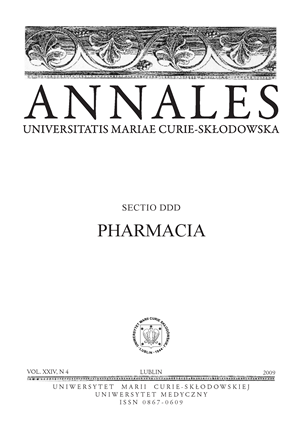Estimation of cortisol in hospitalized patients with depression
Abstract
The aim of this study was to develop the analytical method of the isolation and determination of cortisol from the saliva of depressed women. The material for introduct study was obtained from 10 healthy subjects and was collected in the evening hours, about 8 p.m. when the concentration of cortisol is the lowest. The extraction of the cortisol from saliva was made by liquid-liquid extraction (LLE) by dichloromethane. The level of the hormone was estimated by HPLC with UV detection at 240 nm. The mobile phase contained acetonitrile and water (35:65; v/v) at a flow of 1 mL min-1. The time of retention for cortisol was 2.9 min and for carbamazepine (internal standard) was 4.9 min. The estimated analytical method was validated. Linearity of the calibration curve (r = 0.9997) was obtained in the concentration range of 5–200 ng mL-1 of cortisol in saliva and the limit of detection (S/N = 3) was 1 ng mL-1. The RSD for the intra-assay study varied between 1.1 and 9.9% and in the inter-assay study did not exceed 6.8%. In the intra-assay and inter-assay of the study the accuracy was about 100. The efficiency of the method was made for two different concentrations of cortisol 15 and 125 ng ml-1. The precision for the lower concentration was 7.1% and 8.2% adequate for cortisol spiked after and before the extraction. For the concentration 125 ng ml-1 the efficiency was 3.4% and 2.6%. The estimated method of extraction was applied to analysis of saliva samples without interference peaks. It gave satisfying results and may be a useful toole for monitoring the changes in salivary cortisol.
References
1. Baghai T., Schüle C., Zwanzger P. et al.: Evaluation of a salivary based combined dexamethasone/CRH test in patients with major depression, Psychoneuroendocrinology, 27, 385, 2002.
2. Bandelow B., Wedekind D., Pauls J. et al.: Salivary cortisol in panic attacks. Am v. v. J Psychiatry, 157, 454, 2000.
3. van Cruijsen N., Dullaar t R. P. F., Wit H. P., Alber t F. W. J.: Analysis of cortisoland other stress-related hormones in patients with Ménière’s Disease, Otol Neurotol., 26, 1214, 2005.
4. Dziurkowska E., Wesolowski M.: Evaluation of two techniques for extraction of cortisol from human saliva, Chromatographia, 70, 769, 2009.
5. Kar tsova L. A., Bessonova E. A.: Determination of steroids in biological samples by micellar elektrokinetic chromatography, Anal v. v. Chem v. v., 62, 76, 2007.
6. Kataoka H., Matsuura E., Mit ani K.: Determination of cortisol in human saliva by automated in-tube solid-phase microextraction coupled with liquid chromatography-mass spectrometry, J. Pharm. Biomed. Anal., 44, 160, 2007.
7. Katzung B. G., Masters S. B., Trevor A. J.: Basis and Clinical Pharmacology. Mc Graw Hill, USA, 641, 2004.
8. Lindley S. E., Carlson E. B., Benoit M.: Basal and dexamethasone suppressed salivary cortisol concentrations in the community sample of patients with posttraumatic stress disorder. Biol. Psychiatry, 55, 940, 2004.
9. Masharani U., Shiboski S., Eisner M. D. et al.: Impact of exogenous glucocorticoids use on salivary cortisol measurement among adults with asthma and rhinitis, Psychoneuroendocrinology, 30, 744, 2005.
10. Okumura T., Nakajima Y., Takamat su T., Matsuoka M.: Column-switching highperformance liquids chromatographic system with a laser-induced fluorimetric detector for direct, automated assay of salivary cortisol. J. Chromatogr. B, 670, 11, 1995.
11. Ouellet-Morin I., Dionne G., Pérusse D. et al.: Daytime cortisol secretion in 6-month-old twins: genetic and environmental contributions as a function of early familial adversity. Biol. Psychiatry, 65, 409, 2009.
12. Restituto P., Galofre J. C., Gil M.J. et al.: Advantage of salivary cortisol measurements in the diagnosis of glucocorticoids related disorders. Clin. Biochem., 41, 688, 2008.
13. Tanaka Y., Naruishi N., Nakayama Y. et al.: Development of an analytical method using microchip capillary electrophoresis for the measurement of fluorescein-labeled salivary components in response to exercise stress, J. Chromatogr. A, 1109, 132, 2006.
14. Wallien M.S.C., van Goozen S.H.M., Cohen-Ket tenis P. T.: Physiological correlates of anxiety in children with gender identity disorder. Eur. Child Adolesc Psychiatry, 16, 309, 2007.
15. Yaneva M., Monsier-Pudar H., Dugué M. A. et al.: Midnight salivary cortisol for the initial diagnosis of Cushing’s Syndrome of various causes. J. Clin. Endocrinol. Metab., 7, 3345, 2004.
16. Zhang Y., Kang X., Chen L. et al.: Fiber-packed SPE tips based on electrospun fibers. Anal. Bioanal. Chem., 391, 2189, 2008.
Downloads
Published
Issue
Section
License
Copyright (c) 2009 Authors

This work is licensed under a Creative Commons Attribution-NonCommercial-NoDerivatives 3.0 Unported License.


